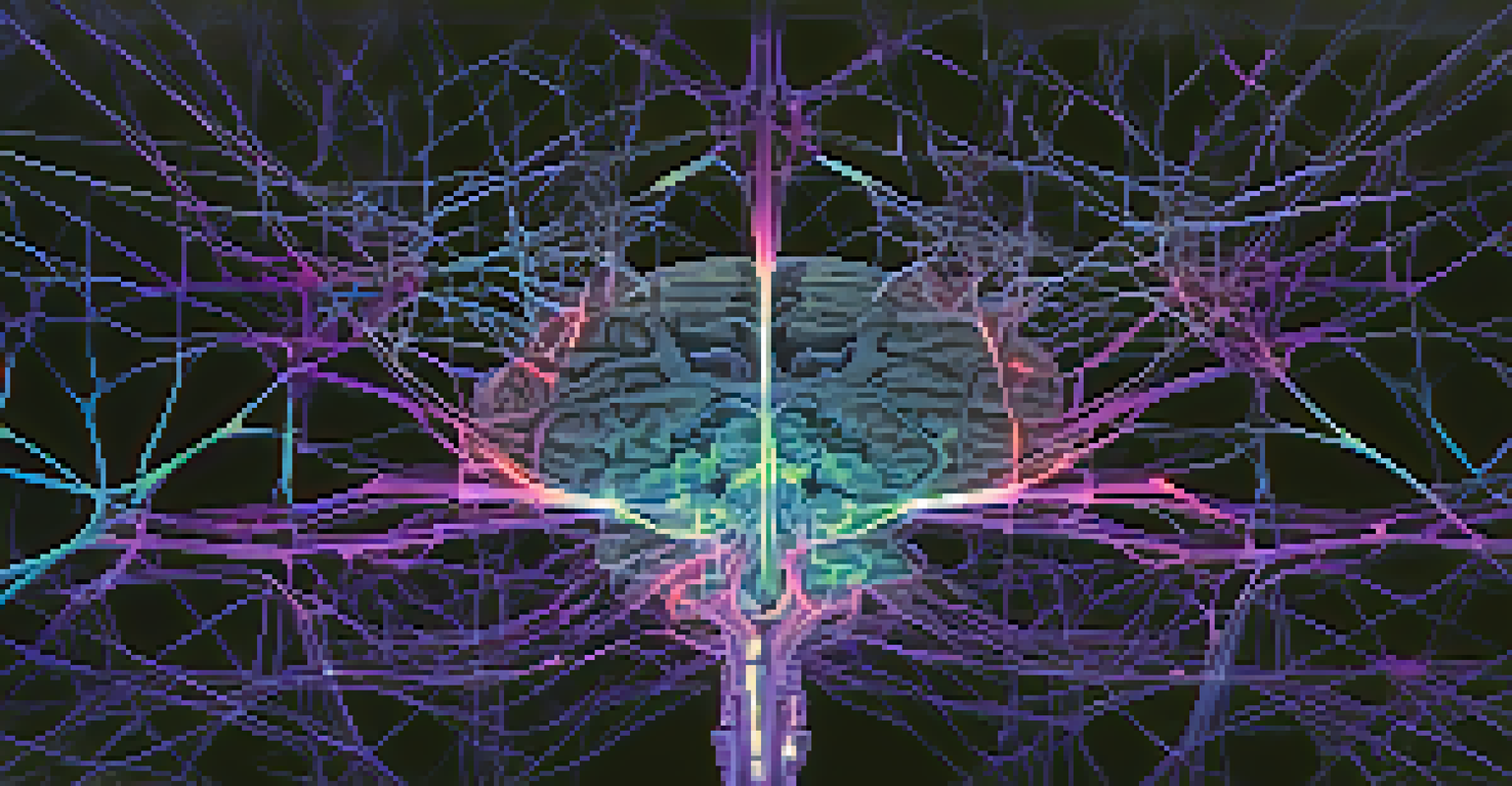How Hallucinogens Alter Connectivity in the DMN

Understanding the Default Mode Network (DMN)
The Default Mode Network (DMN) is a group of brain regions that are active when we are at rest and not focused on the outside world. Think of it as the brain's background chatter, where thoughts about the past, future, and self-reflection occur. This network plays a crucial role in our sense of self and consciousness.
The mind is everything. What you think you become.
Research has shown that the DMN is particularly active during daydreaming or mind-wandering. This is similar to how a computer runs background processes while you are using other applications. When we engage in introspective activities, the DMN helps us connect the dots of our experiences and emotions.
However, the DMN can also be linked to mental health issues, such as depression and anxiety, where excessive rumination occurs. Understanding how hallucinogens interact with this network could provide insights into new therapeutic approaches for these conditions.
What Are Hallucinogens?
Hallucinogens are substances that alter perception, mood, and various cognitive processes. They can lead to visual or auditory hallucinations, changes in thought patterns, and heightened emotional experiences. Common examples include substances like LSD, psilocybin (found in magic mushrooms), and DMT.

These substances often stimulate profound experiences that some users describe as spiritual or enlightening. Imagine looking at the world through a kaleidoscope—everything appears different, and your typical thought patterns are disrupted. This unique state of consciousness can lead to insights and new perspectives.
DMN: The Brain's Background Activity
The Default Mode Network (DMN) is crucial for self-reflection and daydreaming, acting like the brain's background chatter.
While many people seek out hallucinogens for recreational use, there is a growing body of research exploring their potential therapeutic benefits, particularly in mental health treatment. Understanding how they affect brain networks, such as the DMN, is essential for maximizing these benefits.
The Interaction Between Hallucinogens and the DMN
Research suggests that hallucinogens significantly alter the connectivity of the DMN. When these substances are consumed, the usual patterns of activity within the DMN can become disrupted, leading to a more interconnected brain state. This transformation is often likened to a traffic jam clearing, allowing for smoother and more diverse pathways of thought.
Psychedelics can help us learn more about the brain and ourselves.
For instance, studies using brain imaging techniques have shown that while under the influence of hallucinogens, areas of the brain that normally don’t communicate begin to share information more freely. This enhanced connectivity can result in vivid imagery and complex thought processes, much like a painter mixing colors to create a new masterpiece.
Interestingly, this altered state can lead to a sense of unity or connectedness, which many users report feeling during their experiences. This phenomenon might explain why some individuals find profound meaning and insight during hallucinogenic experiences.
Implications for Mental Health Treatments
The changes in DMN connectivity brought on by hallucinogens have sparked interest in their potential for treating mental health disorders. For example, patients suffering from depression or PTSD may experience relief after just a few sessions involving guided psychedelic therapy. This suggests that the disrupted DMN activity could help break negative thought cycles.
Therapists are beginning to explore how these substances can facilitate therapeutic breakthroughs by allowing patients to access and reprocess difficult emotions. Think of it as clearing out clutter from a room; when the mind is freed from its usual constraints, it can allow for healing and growth.
Hallucinogens Alter Brain Connectivity
Research shows that hallucinogens disrupt the DMN, enhancing brain connectivity and potentially leading to profound insights.
Ongoing clinical trials are examining the safety and efficacy of these treatments, aiming to provide evidence-based practices for integrating hallucinogens into mental health care. As we learn more about how these substances affect brain connectivity, we can better understand their therapeutic potential.
Neuroscience Behind Hallucinogens and the DMN
Neuroscience studies have shown that hallucinogens can reduce activity in the DMN while simultaneously enhancing connectivity across other brain regions. This dual effect may explain the profound alterations in perception and self-awareness experienced by users. Imagine a dimmer switch being turned down on the inner dialogue while brightening the connections to the outside world.
Tools like functional MRI scans have allowed researchers to visualize these changes in real-time, offering insights into how hallucinogens might promote a different state of consciousness. As scientists map these neural pathways, they uncover new layers of complexity in how our brains work.
This research is not just academic; it has real-life implications for understanding consciousness and the nature of reality itself. By studying how hallucinogens interact with the DMN, we can expand our knowledge of human cognition.
Limitations and Risks of Hallucinogen Use
While the potential benefits of hallucinogens are exciting, it’s essential to acknowledge the risks and limitations associated with their use. Not everyone responds positively to these substances, and some individuals may experience anxiety or paranoia during their trips. This unpredictability underscores the importance of a controlled and supportive environment when exploring these substances.
Moreover, the long-term effects of repeated hallucinogen use on brain connectivity and mental health are still not fully understood. Just as with any powerful tool, using hallucinogens responsibly and under professional guidance is crucial to mitigate potential harm.
Therapeutic Potential of Psychedelics
The altered DMN activity caused by hallucinogens may provide new therapeutic avenues for treating mental health disorders.
As research continues, it's vital for individuals to stay informed and approach hallucinogens with caution, understanding both their potential and their risks.
The Future of Research on Hallucinogens and DMN Connectivity
As interest in the therapeutic potential of hallucinogens grows, so does the need for rigorous scientific research. Future studies will likely explore the nuances of how different substances affect DMN connectivity and the implications for various mental health conditions. This research could pave the way for innovative treatment protocols that combine psychedelics with psychotherapy.
Moreover, as societal perceptions of hallucinogens shift, we may see a move towards broader acceptance and integration of these substances into mainstream medicine. Imagine a time when psychedelics are part of standard treatment plans for mental health issues, much like antidepressants are today.

Ultimately, understanding the relationship between hallucinogens and DMN connectivity can unlock new pathways for healing and self-discovery, offering hope to those seeking alternative mental health solutions.